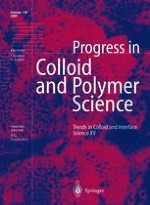2001 | OriginalPaper | Chapter
Elastically ineffective chain formation in networks at high initiator concentration
Authors : I. Lynch, K. A. Dawson
Published in: Trends in Colloid and Interface Science XV
Publisher: Springer Berlin Heidelberg
Included in: Professional Book Archive
Activate our intelligent search to find suitable subject content or patents.
Select sections of text to find matching patents with Artificial Intelligence. powered by
Select sections of text to find additional relevant content using AI-assisted search. powered by
The shrinking kinetics of terpolymer gels composed of 10:20:70 N-tert-butylacryl-amide: N,N’-dimethylacrylamide: N-isopropylacrylamide were found to be sensitive to the initiator concentration in the pregel solution. The gels were synthesised by redox polymerisation using ammonium peroxydisulphate and N,N,N’,N’-tetraethylenediamine, resulting in SO4 groups at the free end of the forming chains. Increasing the initiator concentration resulted in significantly faster shrinking times. The transition temperature and the continuity of the transition were not affected by the initiator concentration, and the degree of swelling at low temperatures was only slightly increased. Thus, there was no evidence of increased osmotic pressure owing to increased charge density. However, the shrinking process was dramatically different for the gel at higher initiator concentration, being 2 orders of magnitude faster, and preventing the formation of a surface skin layer at high temperatures. It is postulated that this resulted from an increased number of growing chains being formed at higher initiator concentration, resulting in an increased number of elastically ineffective chains. It is further postulated that these free chains have increased mobility compared to the network chains, resulting in faster shrinking of gels formed at higher initiator concentration.
